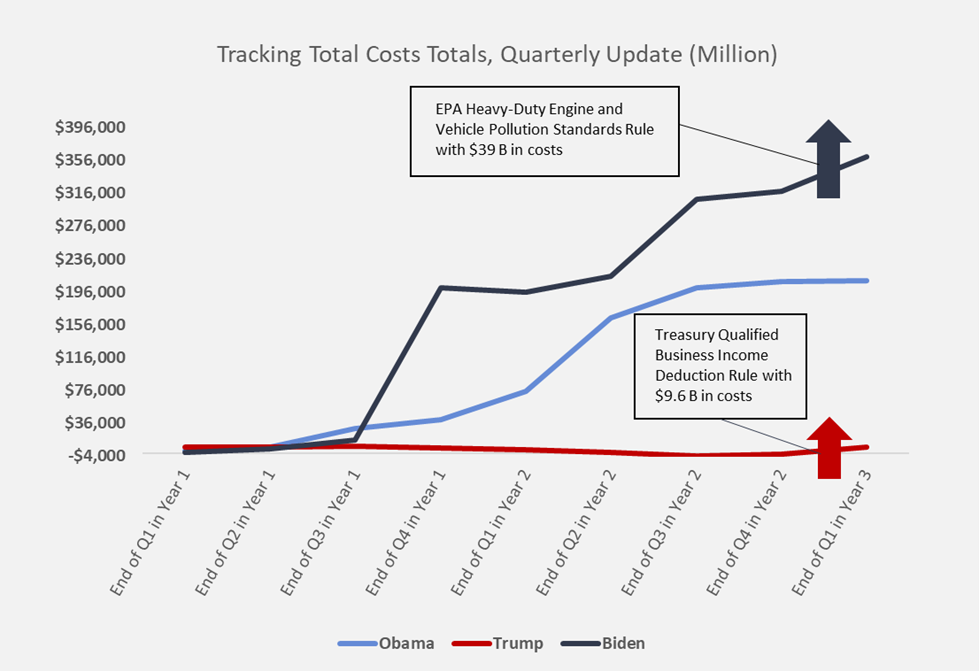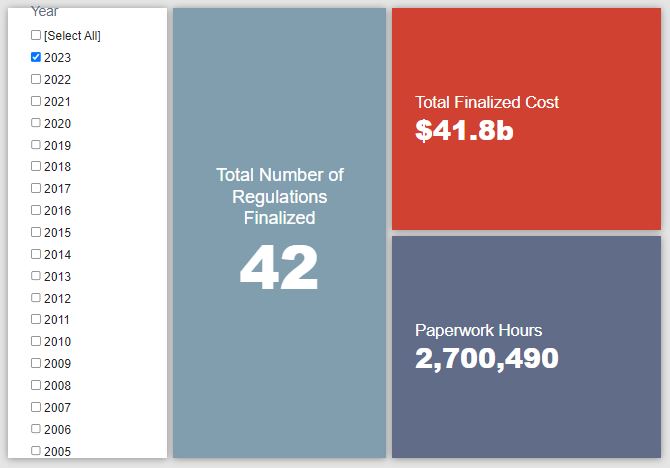Week in Regulation
April 3, 2023
EPA Has Big End to March 2023
Last week may have seemed quiet but was actually quite consequential in the pages of the Federal Register. There were only four rulemakings with some measurable economic impact, none of which were final rules. For such a small sample, however, it left quite a mark. A pair of proposed rules from the Environmental Protection Agency (EPA) were the week’s major items. Across all rulemakings, agencies published $21.5 billion in total costs and added 1.3 million annual paperwork burden hours.
REGULATORY TOPLINES
- Proposed Rules: 43
- Final Rules: 75
- 2023 Total Pages: 19,513
- 2023 Final Rule Costs: $41.8 billion
- 2023 Proposed Rule Costs: $55 billion
NOTABLE REGULATORY ACTIONS
The most significant rulemakings of the week were a pair of proposals from EPA on “PFAS [per- and polyfluorinated substances] National Primary Drinking Water Regulation,” and “Supplemental Effluent Limitations Guidelines and Standards for the Steam Electric Power Generating Point Source Category.” The former marks EPA’s first real foray into regulating “forever chemicals.” As noted here, while the proposal has an admirable goal, there are concerns about the costs it could impose, especially on relevant water safety authorities. EPA estimates that the annualized costs of its currently preferred option would be roughly $1.2 billion (or $18.3 billion in present value over an 82-year horizon). Of note, at least when estimated using a 7-percent discount rate, EPA finds that quantified costs of this option exceed quantified benefits by almost $300 million annually.
The latter rulemaking seeks to revive efforts to regulate “effluent limitations guidelines and standards (ELGs) for the steam electric power” plants in light of legal and administrative hurdles faced by previous efforts on that front. In particular, the proposal “would revise requirements for discharges associated with the two wastestreams addressed in the 2020 rule: BA [bottom ash] transport water and FGD [flue gas desulfurization] wastewater at existing sources. The proposal would also address the 2015 rule CRL [combustion residual leachate] requirements that were vacated.” EPA estimates that these updates to its ELGs regulatory program will involve roughly $200 million in annual costs for affected facilities (or roughly $2.5 billion in present value over a 25-year period).
TRACKING THE ADMINISTRATIONS
As we have already seen from executive orders and memos, the Biden Administration will surely provide plenty of contrasts with the Trump Administration on the regulatory front. And while there is a general expectation that the current administration will seek to broadly restore Obama-esque regulatory actions, there will also be areas where it charts its own course. Since the AAF RegRodeo data extend back to 2005, it is possible to provide weekly updates on how the top-level trends of President Biden’s regulatory record track with those of his two most recent predecessors. The following table provides the cumulative totals of final rules containing some quantified economic impact from each administration through this point in their respective terms.
![]()
As noted earlier, there were no final rules with some quantified economic impact this past week. As such, there was no movement in the Biden Administration’s totals. There was, however, some modest action from the other two administrations. Trump-era costs increased by nearly $240 million, with the majority of that coming from an EPA rule on methylene chloride. The Obama Administration saw a $185 million increase, mostly from a rule implementing the ADA [Americans with Disabilities Act] Amendments Act of 2008.
Quarterly Update
To better illustrate these general trends over time, AAF will provide a look at where each of the covered administrations stands at the end of each quarter in terms of regulatory costs. The graph below provides the latest installment of this series, tracking each administration through March 31 of its third calendar year.

As the above graph illustrates, the Biden and Trump Administrations saw noticeable bumps in regulatory costs while the Obama-era total largely remained steady. The Biden Administration’s cost tally since the start of 2023 increased by nearly $42 billion. The largest chunk of that spike came from the $39 billion in costs from the EPA rule on emissions standards for heavy-duty vehicles. The Trump-era increase primarily came from the administrative burdens attached to a Treasury rule implementing a tax law provision. With that increase, the Trump Administration’s final rule tally moved back into net-cost territory after a roughly six-month span in which it could claim net savings.
THIS WEEK’S REGULATORY PICTURE
This week, the Federal Government takes a second look at its regulatory classification of “soybeans of other colors (SBOC).”

Source: Photo by Meredith Petrick on Unsplash
Last Friday, the Department of Agriculture (USDA) published a proposed rule with the simple, innocuous title of “United States Standards for Soybeans.” In particular with this rulemaking, USDA seeks to update said standards “by removing soybeans of other colors (SBOC) as an official factor” and “revise the table of Grade Limits and Breakpoints for Soybeans to reflect this change.”
The proposal comes at the behest of soybean producers. The agency describes why soybean coloration is becoming an issue thusly:
Until recently, yellow soybeans have shown phenotypic stability in seedcoat color; however, modern breeding technologies have produced varieties that have a higher tendency to demonstrate variations in seed coat color. Industry interactions (with producer groups, exporters, grain elevators, and grain processors) suggest that these varieties are gaining popularity with soybean growers and likely will be present in the value chain for the foreseeable future.
USDA goes on to note that the results of a 2022 study “show no significant correlation between SBOC and protein and oil content.” Essentially, under current standards, soybeans are being graded by their coloration, even if these color variations have no material impact on the crop’s actual quality.
This misalignment between grading criteria and actual quality can impact the price at which producers can sell their product. For instance, there are currently four grades of SBOC under USDA guidelines, and the agency finds that those deemed to be in “grades #3 and #4 are discounted by 1.5 cents and 3.5 cents” per bushel. Extrapolate that out across the roughly 230 million bushels sold each year and that amounts to roughly $3.8 million in unrealized revenue for affected producers. Interested parties have until May 1 to submit comment on the matter.
TOTAL BURDENS
Since January 1, the federal government has published $96.8 billion in total net costs (with $41.8 billion in new costs from finalized rules) and 12.2 million hours of net annual paperwork burden increases (with 2.7 million hours in increases from final rules).











